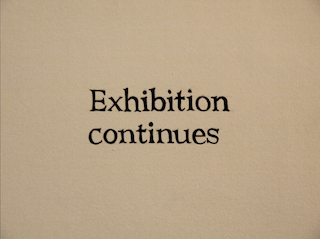Ignasi Aballí is one of the few artists to have successfully reinstated the formal, linguistic and social enquiries of early Conceptualism, investing them with contemporary relevance, a leavening humour and a grasp of contemporary technology that, in his films, drags those silent one-reelers of the 1960s and 70s into the present. Employing numerous media and methods of display, the investigations of the fifty-seven-year-old Barcelonan artist – who has won the 2015 Joan Miró Prize – encompass art history, painting, books, the media, photography, installation and, yes, film and video.
In a series represented by Dust (10 years in the studio) (2005), Aballí literally turns dust into an artform, leaving canvases to collect the grime of the studio for protracted periods. The exhibition could have focused more on this seminal series, as it provides an easy entrée into two of the artist’s main themes: time and accumulation. In the ‘newspaper’ series, specific words cut from a national paper’s headlines are reassembled as collaged lists, establishing taxonomies and timeframes that critique the media’s supposed objectivity. For example, in 2012–13 the USA was referenced over 600 times compared to Estonia’s solitary inclusion. While exposing surprising political and linguistic relationships, here – as in Aballí’s 2015 thesauruslike compendiums of descriptive terms for basic colours – this linkage becomes an exhaustive cataloguing of thematic variations. The sheer overload leads to a paradoxical redundancy of meaning, returning information to the status of objecthood.
This underpinning sense of absence within presence – or, conversely, an existential quest for meaning within nothingness – was first developed from the 1980s in the ‘resin paintings’ (acrylic gel), again underrepresented, in which a semitransparent patina stands in for the picture plane. The theme continues in pages extracted from books, leaving only those with an index or chapter numbers as an armature upon which to reconstruct the absent whole. Elsewhere, an art-history lecture is assembled from slides bleached to incoherence by lengthy exposure to sunlight.
Referencing 1960s experimental film-making, light – cinema’s fundamental medium – is again the point of enquiry in Film Projection (2012), where the camera looks directly into the projector lens during a screening. An indexical relation to the ongoing movie is maintained, but any sense of narrative is lost as the image deconstructs into an ethereal, undulating incandescence.
Much of Aballí’s work addresses the specifics of museological display, such as titles simply identifying the white in which a wall is painted. Photographed corners in Amsterdam reveal the confluence of streets named after famous artists in a parody of the ‘arbitrary’ conjunctions between artists’ works in museums. In a further photographic series, typical museum signage warns us not to touch or of CCTV surveillance, but we are never quite sure if these are actively addressed to us or are passive images subsumed within the exhibition. Building on this in-between status, vitrines become art objects in their own right. Bearing self-referential texts and images, they continually return us to their Plexiglas corporeality in an unending conceptual loop that vacillates between art as messenger and as the thing-in-itself.
Foregrounding the display inevitably broaches the age-old relationship between museum approbation and commercial value. Again, this is approached with understated humour: here, eight monochrome ‘paintings’ – standard fare for the modern museum – are composited from shredded banknotes. The colour of money initially equates with face value; the context reminds us that it is institutional approval that confers commercial worth.
While Aballí’s plural concerns are compressed like his shredded banknotes, though in more denominations, common threads weaving between different series turn a cacophony into a rich and coherent tapestry of provocative questions. Crystallising the interdependence of absence and presence, finality and processes without end, Aballí achieves this with a subtlety and economy that pays reverent homage to its conceptual lineage.
Museo Nacional Centro de Arte Reina Sofía, Madrid 28 October – 27 March
This article first appeared in the January & February 2016 issue of ArtReview.
